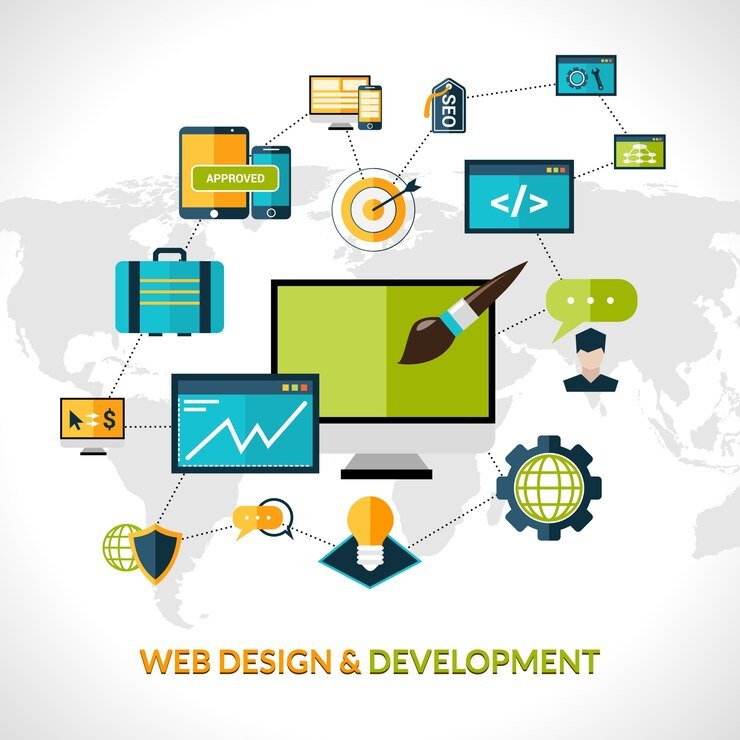A Comprehensive Guide to Web Designing and Development
In the vast realm of the internet, where information flows seamlessly, web designing and development stand as the architectural backbone that shapes the digital landscapes we interact with daily. Whether you’re a business owner, an aspiring developer, or simply curious about the intricacies of the online world, this comprehensive guide aims to unravel the mysteries surrounding web designing and development.
What is Web Designing and Development?
Web Designing:
Web designing is the creative process of conceptualizing and visually crafting the layout, structure, and overall aesthetics of a website. It involves the use of graphic design elements, user interface (UI) design, and other visual elements to create an engaging and user-friendly experience. A well-designed website seamlessly blends form and function, providing an intuitive interface for users to navigate and interact with the content.

Web Development:
On the other side of the spectrum, web development is the technical process that brings the design to life. It encompasses a range of activities, including web programming, coding, and database management, to ensure the website functions as intended. Web developers focus on the backend and frontend aspects of a site, ensuring that it not only looks appealing but also operates smoothly and efficiently.

The Symbiotic Relationship: Web Design and Development
Collaboration between Designers and Developers:
While web designing and development are distinct disciplines, their collaboration is essential for creating a harmonious and functional website. Designers work on the visual aspects, including layout, color schemes, and typography, while developers bring these designs to life by writing code, implementing features, and ensuring the site’s responsiveness across various devices.
The Role of UI/UX Design:
User experience (UX) and user interface (UI) design play a pivotal role in web designing and development. UX design focuses on understanding users’ needs and creating a seamless, enjoyable journey through the website. UI design, on the other hand, deals with the visual elements that users interact with, ensuring an aesthetically pleasing and intuitive interface.
How to Develop a Website: A Step-by-Step Guide
Define Your Purpose and Target Audience:
Before diving into web designing and development, it’s crucial to define the purpose of your website and identify your target audience. Understanding these aspects will guide decisions related to design, content, and functionality.
Choose a Domain Name and Hosting:
Selecting a domain name that reflects your brand and securing reliable hosting are fundamental steps in the website development process. The domain is your web address while hosting provides the server space where your website’s files are stored.
Plan Your Website Structure:
Create a sitemap to outline the structure of your website. This visual representation helps organize the pages and navigation, ensuring a logical flow for users.
Design Wireframes and Mockups:
Web designers often start with wireframes, which are basic sketches outlining the structure of each page. Mockups, on the other hand, are detailed visual representations of the final design, providing a clearer picture of the website’s look and feel.
Development of Backend and Frontend:
Web development involves two main components – backend and frontend. Backend development focuses on the server-side functionality, databases, and server configurations. Frontend development deals with the user interface, ensuring a visually appealing and responsive design.
Implement Content Management System (CMS):
For websites with frequently updated content, integrating a content management system (CMS) simplifies the process of content creation and management. Popular CMS options include WordPress, Joomla, and Drupal.

Incorporate SEO Best Practices:
Optimizing your website for search engines is crucial for visibility. Implement on-page and off-page SEO strategies, including keyword optimization, meta tags, and creating high-quality, shareable content.
Test Across Different Devices and Browsers:
Ensure your website is responsive and functions seamlessly across various devices and browsers. Testing helps identify and fix any issues that may impact the user experience.
Launch Your Website:
Once testing is complete and you’re satisfied with the final product, it’s time to launch your website. Register your domain, configure your hosting settings, and make your site accessible to the world.
Monitor and Update:
Website development is an ongoing process. Regularly monitor your website’s performance, analyze user behavior, and make updates or improvements as needed.
FAQs: Frequently Asked Questions
Q1: What is the difference between web design and web development?
A: Web design focuses on the visual aspects of a website, including layout, color schemes, and typography. Web development involves the technical implementation of these designs, encompassing coding, programming, and database management.
Q2: Can I learn web design and development on my own?
A: Yes, many resources, including online courses, tutorials, and documentation, are available for individuals interested in learning web design and development. However, gaining practical experience through hands-on projects is crucial for skill development.
Q3: Do I need to learn coding for web development?
A: While it’s beneficial to have coding skills for web development, there are website builders and content management systems that allow individuals to create websites without extensive coding knowledge. However, a deeper understanding of coding can provide more flexibility and customization options.
Q4: How long does it take to develop a website?
A: The time required to develop a website depends on various factors, including its complexity, features, and the skills of the developer. A simple website may take a few weeks, while a more complex site could take several months.
Q5: What is the importance of responsive design?
A: Responsive design ensures that a website adapts and functions well on different devices and screen sizes. With the increasing use of smartphones and tablets, responsive design is crucial for providing a positive user experience across various platforms.
Q6: Can I update my website after it’s launched?
A: Yes, websites are meant to evolve and adapt. Regular updates, content additions, and improvements are essential for keeping your website relevant and meeting the changing needs of your audience.
Q7: Is web development a good career choice?
A: Yes, web development is a sought-after career with a growing demand for skilled professionals. As businesses and individuals continue to establish an online presence, the need for competent web developers remains high.
Q: What are the essential skills for a web designer?
A: Key skills for web designers include proficiency in graphic design tools, understanding of user experience principles, knowledge of design principles and trends, and the ability to work with coding languages like HTML and CSS.
Q9: Can I hire professionals for web designing and development?
A: Absolutely. Many web design and development agencies, as well as freelancers, offer their services. Hiring professionals ensures that your website is crafted with expertise, meets industry standards, and provides a positive user experience.
Q10: What is the significance of SEO in web development?
A: SEO (Search Engine Optimization) is crucial for enhancing the visibility of your website on search engines. Implementing SEO best practices during the web development process helps attract organic traffic and improves your website’s chances of ranking higher in search results.
Conclusion:
In conclusion, web designing and development are interconnected disciplines that play a pivotal role in shaping the online experiences we encounter daily. From the creative process of designing visually appealing interfaces to the technical intricacies of coding and functionality, the world of web design and development is dynamic and ever-evolving.
Whether you’re embarking on a journey to develop your website or seeking to understand the intricacies of the online world, this guide aims to provide a comprehensive overview. By delving into the symbiotic relationship between design and development, exploring the step-by-step process of website development, and addressing frequently asked questions, we hope to empower you with the knowledge to navigate and appreciate the vast and exciting realm of web design and development.

